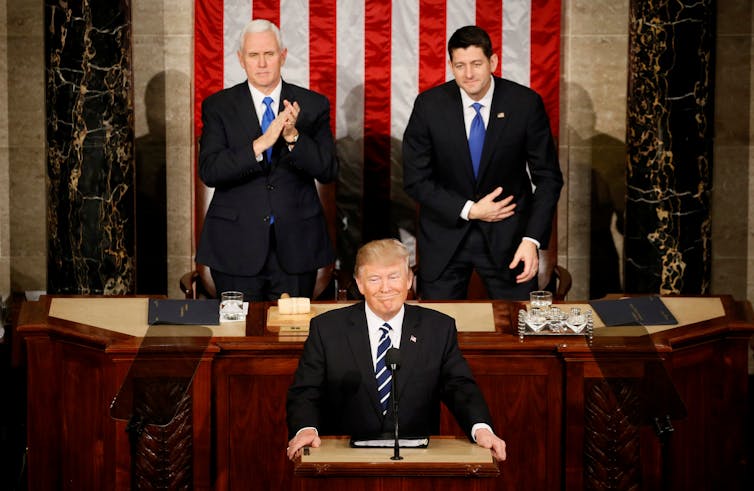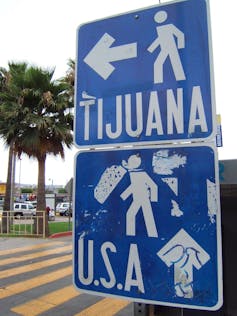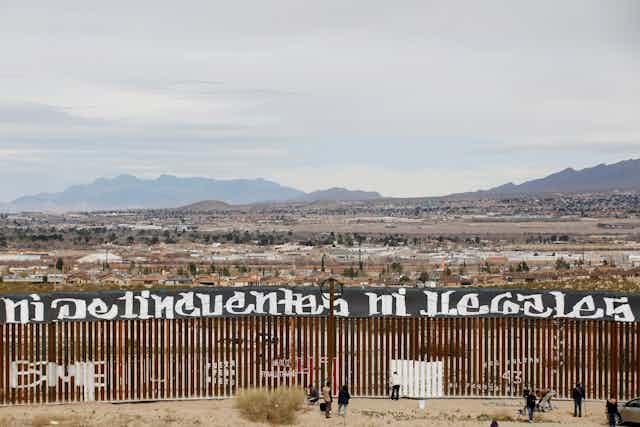It’s not easy to share a 3,000km border with a superpower.
As Mexican novelist and Nobel laureate Octavio Paz once wrote, Mexicans live in the shadow of a two-faced giant, alternately a naïve and good-natured colossus or a “cunning and bloodthirsty” monster.
US President Donald Trump, who has relentlessly intimidated and humiliated Mexico since before he was sworn in, evidently enjoys playing the ogre. He has repeatedly demanded that Mexico treat the US “fairly and with respect” while blaming it for “taking advantage” of its northern neighbour.
Who’s the bully?
History says otherwise, of course. The first 300,000 Mexican-Americans came into existence when President James Polk invaded Mexico in 1846 and stole 55% of its land, including Texas and California. By July 2015 some 35.8 million people identified as Mexican American – 11% of the total US population.
Such are the human bridges that today unite the two countries; and Trump’s sabre-rattling represents a profound threat to regional peace, security and commerce.
In Mexico, Trump’s hostility has prompted a surge of anti-American nationalism. And after months of erratic and hesitant responses to his Northern counterpart, President Enrique Peña Nieto’s approval rating of 17% is the lowest ever recorded for a Mexican president.
After a February 22-23 US state visit to Mexico turned from merely awkward to openly hostile, Mexico’s government finally ran out of patience. Luis Videgaray, Mexico’s secretary of foreign affairs, ominously told the Los Angeles Times that the Trump administration’s next steps will determine “how Mexico and the US coexist” in coming decades.

Trump’s NAFTA myths
The North American Free Trade Agreement (NAFTA) used to be the flagship of the friendly relations between Mexico and the US.
As recently as July 2015, the US government was praising Mexico as a “critically important” partner in America’s well-being; 14 years prior, George W Bush acknowledged that the US has “no more important relationship in the world” than the one it has with Mexico.
The good feelings from prior consecutive American administrations toward Mexico reflect former US presidents’ knowledge that the achievements of NAFTA – for economists largely agree that the agreement has provided more benefits than harm to the US economy – required sacrifices on both sides of the border.
Jobs were not exclusively lost in the declining US industrial heartland known as the Rust Belt. NAFTA has also imposed huge costs on the Mexican agricultural sector, eliminating 1.3 million agriculture jobs. Poor farmers, forced to compete at local markets with heavily subsidised corn and other staples from the US, just couldn’t make it work.
Trump’s recent argument in an address to Congress that the US has “lost more than one-fourth” of its manufacturing jobs to Mexico notwithstanding, an accompanying shift towards the service economy means the drop in manufacturing has had only a modest overall effect on the US job market. In fact, automation has had a bigger impact.
Service gigs are often low-paying and unstable, but the challenges of the US working class go deeper than NAFTA. Across the globe, a new social class of precarious workers – the precariat – has emerged as a result of the entrenchment of neoliberal capitalism all over the world. In Mexico, for example, many of those NAFTA-derived manufacturing jobs pay the daily minimum wage of 80 pesos – around US$4.00.
Rather than concern himself about labour standards, the US president has railed against the US goods trade deficit with Mexico, which amounted to US$58 billion in 2015. He ignores that nearly 2 million US jobs also now depend on exports to Mexico, and that the US has grown US$127 billion richer each year because of extra NAFTA trade.
The gringo ogre is back, with a vengeance.

The beacon of hostility
It was immigration that finally pushed Mexico’s government over the edge.
Those hardline executive orders on border security and immigration enforcement? Not just empty threats: roughly half of the 11 million unauthorised immigrants in the US are Mexican, and Trump wants them out. Bids for contracts to build the US-Mexico border wall are scheduled to open on March 6.
Deportation priorities have also been drastically expanded. John Kelly, Secretary of Homeland Security, has issued instructions to target undocumented immigrants who’ve been in the US up to two years for “expedited removal” without court authorisation.
Immigrants can now be deported for virtually any misstep, from using false documents to posing a (subjective) “risk to public safety or national security”. Paying smugglers to bring your children across the border has become a prosecutable offence, subjecting entire families to deportation.
These rules will spur violations of civil liberties, and they’re already causing human suffering across Mexico and the US. Asylum-seekers are stuck in legal limbo at the border. Immigrants hide in fear. Families have been torn apart.
In the US, some 38% of US-born Latinos, 34% of Latino immigrants with US citizenship, and 49% of Latino immigrants who are lawful permanent residents now have serious concerns about whether they can still call the US “home”.

Trump’s draconian immigration policies derive from a profoundly inaccurate assessment of the situation in the US.
Every day, one million individuals legally cross the border in a peaceful manner.
An estimated 5% of America’s civilian workforce is undocumented. And no wall will stop Mexican job-seekers as long as American employers – like Andrew Puzder, Trump’s first nominee to lead the Labour Department, who admitted to employing an undocumented house cleaner – continue incorporating them. On the other hand, about one million Mexican immigrants have already freely returned home between 2009 and 2014, partly because of Mexico’s own economic growth.

Trump has also erroneously and irresponsibly stigmatised immigrants as criminals who “prey” on “very innocent” American citizens. Several studies, over many years, have established that immigrants and crime are not connected.
But the Trump administration, with its alternative facts, asserts that there’s been a “surge of immigration at the southern border” that’s causing “significant national security vulnerability”. Secretary Kelly is even insisting that the US can return all people caught crossing the US-Mexico border illegally to Mexico even if they’re not Mexican.
Standing up to the bully
Mexico reacted with anger to the new rules, which were issued hours before Kelly and Secretary of State Rex Tillerson arrived in Mexico City for their first official visit.
Luis Videgaray responded by indicating that “the Mexican people do not have to accept measures that one government wants to unilaterally impose on another.” Kelly, trying to calm the row, assured the Mexican government that there would be “no mass deportations” and “no use of military force in immigration.”
But before the visit was over, Trump had already contradicted his DHS secretary by describing the US crackdown as a “military operation” that’s getting “the bad dudes out at a rate that nobody has ever seen before.”
That was the last straw for the Mexican government.
On Tuesday February 28 – while pundits praised the “presidential” tone of Trump’s address to Congress – Foreign Secretary Videgaray defined his country’s strategy going forward: open defiance.
In a six-hour senate hearing, Videgaray said that his office had clearly communicated to Kelly and Tillerson “the feeling of offence and indignation that exists in Mexico”. He then outlined the country’s new ground rules for immigration, security, trade and border policy.
First, Videgaray cautioned, “the human rights of Mexicans in the US should be absolutely respected” and said that Mexico would not “hesitate to resort to the US courts and to international organisms” if necessary. Indeed, as he noted, this topic has already been raised in Mexico’s meetings with the UN High Commissioner for Human Rights.
Mexico will also now reject any attempt to enforce Trump’s executive orders beyond US territory, refusing to further militarise the border and or to use military force against migrants, as Trump had recently urged Peña Nieto.
In a complementary pivot toward Central America, Videgaray said that development, not immigration control, will now determine Mexico’s relationship with Guatemala, Honduras and El Salvador. In recent years, Mexico had intensified enforcement at its southern border to stem migrants fleeing the troubled region for the US. Now Mexico vows to display “a more active, more supportive presence” there.
To mitigate fall out from increasing US protectionism, Mexico is diversifying its trade partnerships, now privileging Argentina, Brazil, Japan and China. Videgaray advised that any renegotiation of NAFTA must help raise salaries in Mexico, saying it’s “not right” to promote a trade project that “only attracts foreign investment to Mexico for its cheap labour.”
Finally, the Mexican government is also demanding that the US assume its neglected “historic responsibility” for drug consumption, arms trafficking and money laundering and acknowledge the role its law enforcement agencies have played in the country’s drug-related violence.
A new era in the US-Mexican relationship has begun. And as these interdependent countries embark a collision course, they are, paradoxically, drifting apart.

